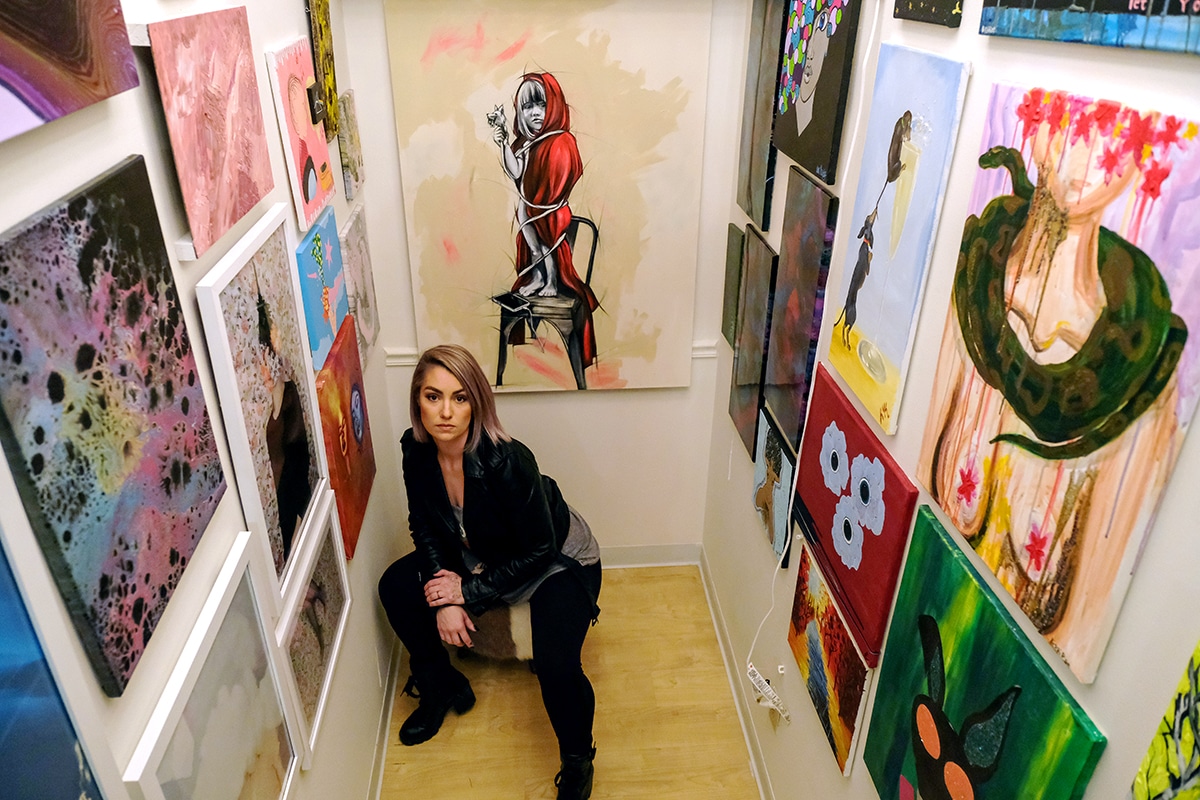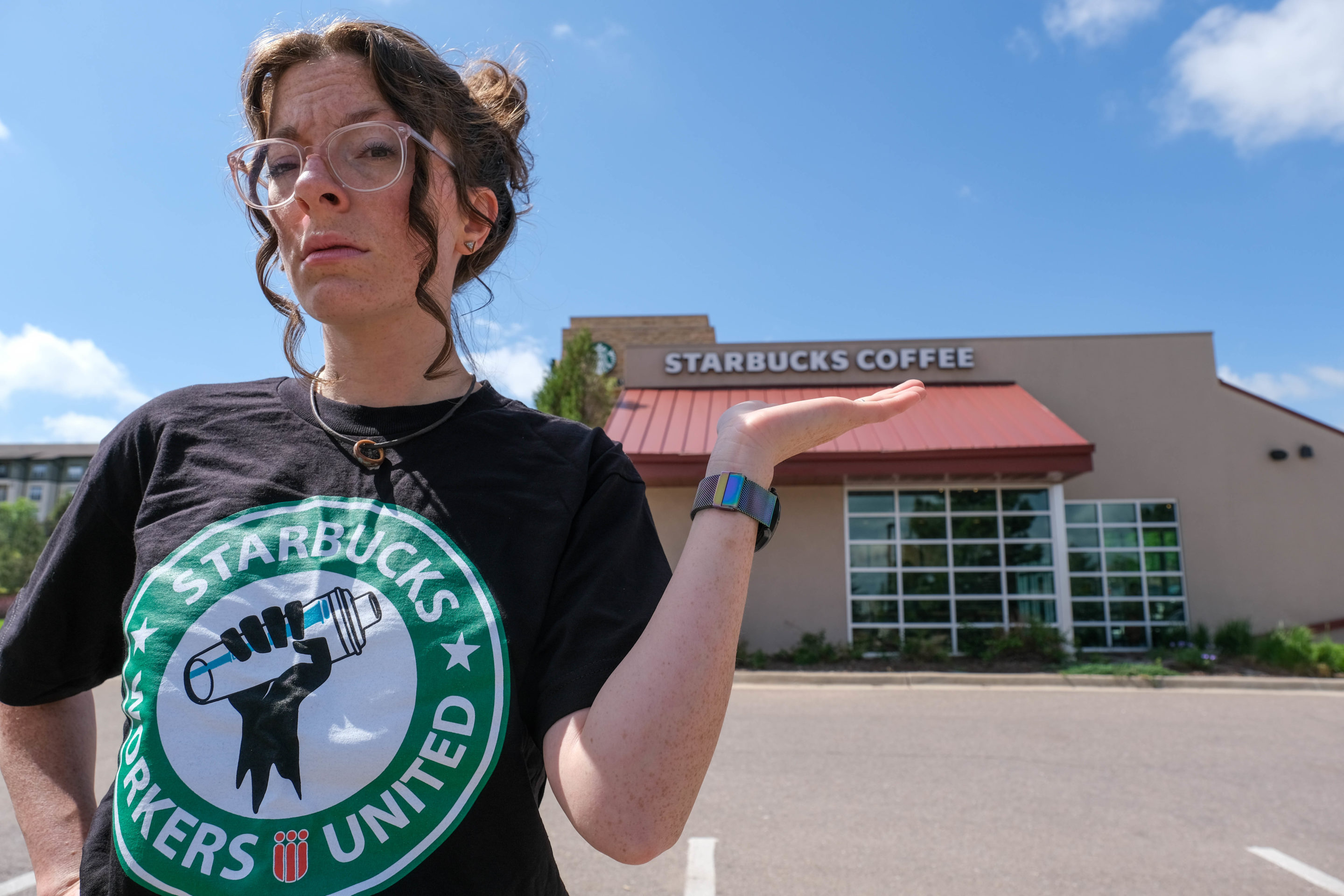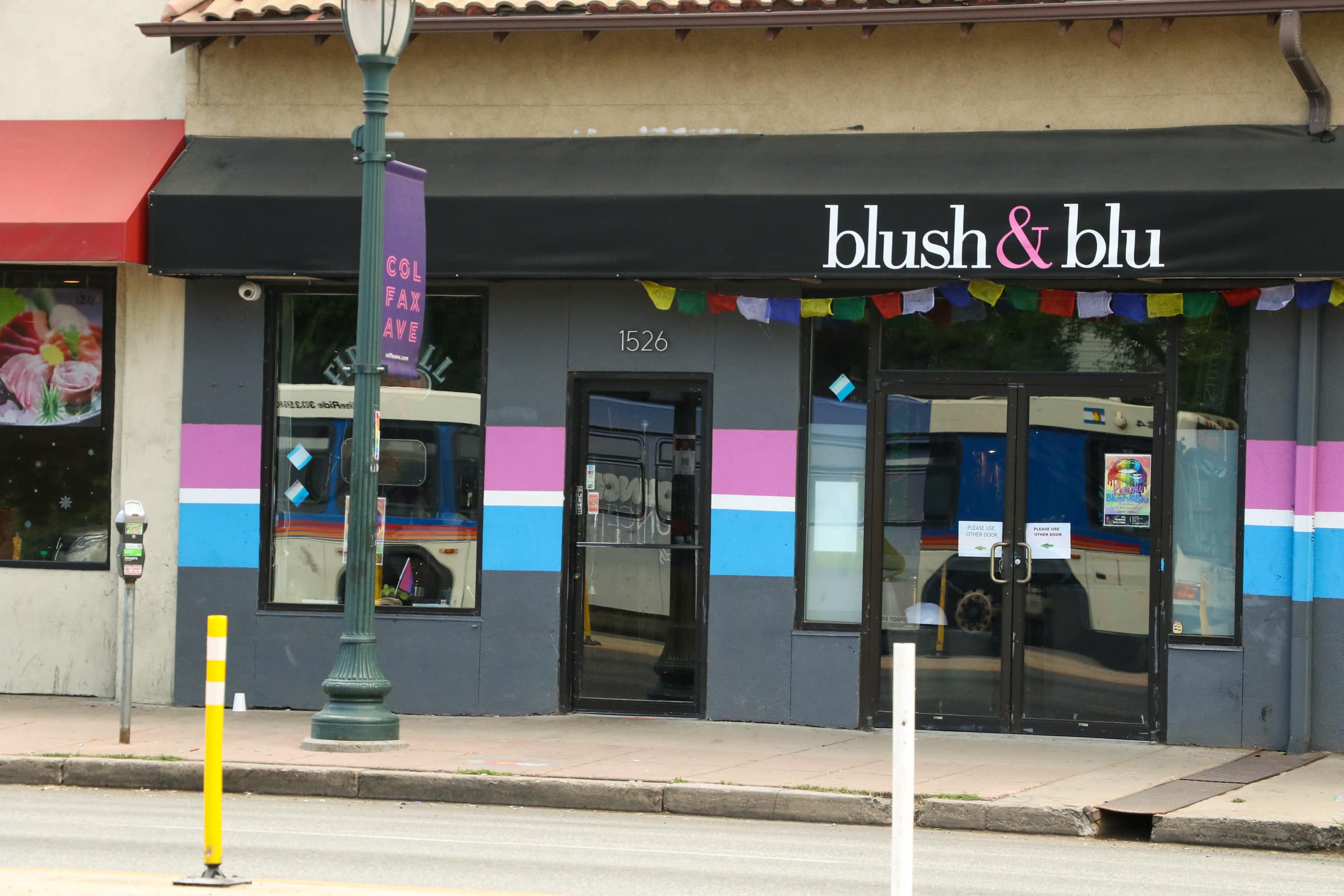//Artist Amy Lummus sits beneath a portrait of her daughter, Penny, at the Electric Cherry Shop + Studio in Olde Town Arvada on April 16. Photo by Esteban Fernandez | [email protected]
With arched backs and mouths slightly agape, Amy Lummus’ pin-up portraits of American women illustrate the ultimate feminine in the face of self-sacrifice. Dressed in late 50s and early 60s attire, her powerful, metaphor-heavy and sometimes disjointed imagery speaks to the gender bias that continues to infiltrate society’s porous cracks today. Especially in the fine art scene, this Denver local believes female-identifying artists are largely underrepresented in the craft’s vital leadership roles, affecting whose art is shown in gallery spaces.
As a single mother and artist for the past decade, Lummus admits she’s never met a single female fine art curator nor another single mother working full-time as an artist. But that’s not to say they don’t exist. Her observations only reinforced her belief that the clear disparity in representation strips artwork of its earnestness and authenticity.
“My acceptance into art shows went up 70% in a year when I lost my first name,” Lummus said, who in a maneuver devised by a fellow female artist goes by the pen name A.L. Lummus. “Since dropping my first name, I’ve shown all over the country. Prior to that, I could barely get into a local show.”
The barrier is not women getting into the field, but rather staying in it. Women are the majority of fine arts degrees, yet make up the minority of working artists across all disciplines. This statistic, shared by Lummus, is the reason many local artists praise community and connection over formal education if the latter is inaccessible.
Ally Skiba, artist and founder of Electric Cherry Shop and Studios in Arvada, wanted to create an outlet for Denver creatives looking for a space to sell their work.
“At Electric Shop and Studios, we have every kind of artist,” Skiba said. “There’s no aesthetic. The artist can show what they like.”
Even though Skiba went to art school, female mentorships are what ultimately elevated her career. Lummus is one of the 60 artists involved in Skiba’s art collective and praised her grassroots efforts for promoting local artwork.
“It’s not easy sometimes as a female in the art world to get your message across or heard,” Skiba said. “It’s kind of like the pay rate when it comes to any kind of job by a female—it’s the same thing. I think we have a lot of work to do to change that. But I think we’re on our way. I think a lot of females are banding together and I have nothing to say but gratitude for the women that have helped me pull this off because I couldn’t have done it by myself.”
While Denver has a devoted community within the arts, it is not exempt from the international data indicating that only 13.7% of living artists represented by galleries in North America and Europe are women. In the United States, women not only occupy fewer directorships at art museums than their male counterparts, but they earn up to $0.75 for every dollar earned by male directors.
“All the opportunities that were offered to me came from putting myself out there in the community,” Skiba said.
After moving to Denver five years ago, Skiba said the state’s art scene allowed her to grow further as an artist. Her communal approach—hosting collaborative events with local artisans and creatives to becoming a board member in Old Town Arvada—has allowed her to shine a spotlight on her shop and the artists within it.
“There aren’t a lot of females actually running these spaces,” Skiba said. “Here and there, I’ll meet a few but they are very male-driven and that can influence what style or story of art goes into the gallery space.”
Sarah Rockett, coordinator of creative and public engagement at the Denver Art Museum, has an intertwined relationship between her personal creative practice and social work at the museum. After serving as the creative in residence in 2018, she joined the museum staff to help change the culture for other working artists and supplement her income as an artist.
As reported by the National Museum of Women in the Arts, women make up a majority of professional art museum staff, yet remain underrepresented in leadership positions.
“In my own personal path, I think that was something that sent me in a different personal direction towards working within arts nonprofit organizations—to be able to further some of my own goals within the art world rather than just trying to express them through my artwork,” Rockett said.
Rockett currently leads the museum’s Untitled program, a quarterly collaboration with local artists who create a series of public presentations and experiences. The two featured artists for each event pull from their own creative network, laying the groundwork for collaboration and community.
Rockett’s most recent personal creative endeavor was a crochet piece titled “RIP/RBG” in honor of Ruth Bader Ginsberg’s passing. The piece was featured in Alto Gallery’s “Fray” exhibition, which was notably curated by the female duo behind We Were Wild, which specializes in collage installations.
Lummus says creating lasting change necessitates working together. She emphasizes it’s not about following a “me versus them” construct, but rather striving for equal representation.
“When people say, ‘I’m an artist,’ I always say, ‘You are? So, what are you doing right now? What are you creating? What are you making?’” Lummus said. “But in reality, the essence of what I’m asking is, ‘What are we changing? What are you doing for the world?’ Art is everything. It’s the history, the connections we make to our past.”
Following the success of Lummus’ first solo exhibit at BitFactory Gallery, gallery owner and curator Bill Thomason says he is hosting his first all-female exhibition at the end of the year under the theme of gender equality in the arts.
“It seems like society is at a point where it’s ready to hear this message,” Thomason said. “It’s something that needs to be discussed and discussed and discussed.”
Lummus emphasizes it doesn’t matter if it’s 200 years from now, but someone will take her and other female artists seriously.
“They say gender [equality] will take another 108 years, and maybe when that’s happened, we all look back and say, ‘Oh my god, those women were pissed!’” she said.
Enjoyed this story? Help us keep the lights on! Supporting local press ensures the stories you want to read keep coming, become a member for free today! Click here.





Very late to this article, but in the last 20 years, nearly every single gallery owner and position of power in the visual art scene in my state (Indiana) that I’ve interacted with has been a woman. The major museums, the galleries and other art spaces? All run by women for the most part. A few men here and there, but not many. I’m all for women being empowered and having an equal say in what’s going on arts-wise, but at this point the scales are tipped heavily towards women here, so I’m having a very hard time believing women who say it’s mostly men when all I see are women in leadership positions.